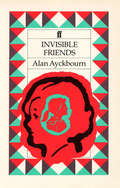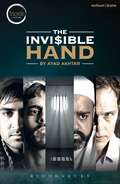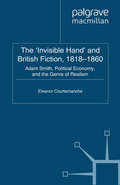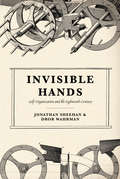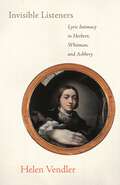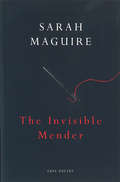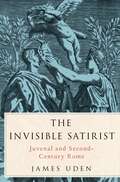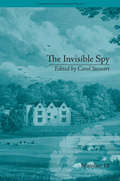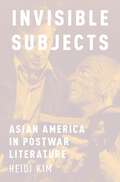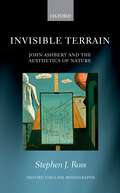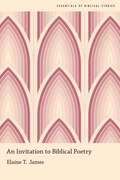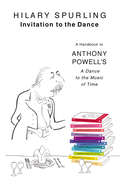- Table View
- List View
Invisible Friends: Ernie's Incredible Illucinations, Invisible Friends, This Is Where We Came In, My Very Own Story, The Champion Of Paribanou
by Alan AyckbournAlan Ayckbourn's play is about a very ordinary teenager called Lucy. With her father glued to the cowboys on the telly, her mother preoccupied with neighbourly gossip and her brother enclosed in his ear-phones, no one wants to know about her place in the school swimming team. So Lucy revives her childhood fantasy friend, Zara, setting a place for her at the very ordinary tea table. This time Zara materializes, bringing with her an idealized father and brother, and showing Lucy how to make her real family vanish. The moral of this cautionary tale is carefully spelt out - that when you get what you want it's not what you wanted - as Lucy's dream family turns out to be a nightmare. The play is supposedly for children of seven upwards, but there's a message here for parents, too, about listening to kids.
The Invisible Hand (Modern Plays)
by Ayad AkhtarWe are prisoners of a corrupt country of our own makingAmerican banker Nick Bright knows that his freedom comes at a price. Confined to a cell within the depths of rural Pakistan, every second counts. Who will decide his fate? His captors, or the whims of the market?Pulitzer Prize–winning playwright Ayad Akhtar has written an intense, fast-moving political thriller, which lays bare the raw, unfettered power of global finance.The Invisible Hand received its world premiere at the New York Theatre Workshop on 8 December 2014 and its UK premiere at the Tricycle Theatre, London, on 12 May 2016.
The 'Invisible Hand' and British Fiction, 1818-1860: Adam Smith, Political Economy, and the Genre of Realism (Palgrave Studies in Nineteenth-Century Writing and Culture)
by E. CourtemancheThe 'invisible hand', Adam Smith's metaphor for the morality of capitalism, is explored in this text as being far more subtle and intricate than is usually understood, with many British realist fiction writers (Austen, Dickens, Gaskell, Eliot) having absorbed his model of ironic causality in complex societies and turned it to their own purposes.
Invisible Hands: Self-Organization and the Eighteenth Century
by Jonathan Sheehan Dror WahrmanWhy is the world orderly, and how does this order come to be? Human beings inhabit a multitude of apparently ordered systems—natural, social, political, economic, cognitive, and others—whose origins and purposes are often obscure. In the eighteenth century, older certainties about such orders, rooted in either divine providence or the mechanical operations of nature, began to fall away. In their place arose a new appreciation for the complexity of things, a new recognition of the world’s disorder and randomness, new doubts about simple relations of cause and effect—but with them also a new ability to imagine the world’s orders, whether natural or manmade, as self-organizing. If large systems are left to their own devices, eighteenth-century Europeans increasingly came to believe, order will emerge on its own without any need for external design or direction. In Invisible Hands, Jonathan Sheehan and Dror Wahrman trace the many appearances of the language of self-organization in the eighteenth-century West. Across an array of domains, including religion, society, philosophy, science, politics, economy, and law, they show how and why this way of thinking came into the public view, then grew in prominence and arrived at the threshold of the nineteenth century in versatile, multifarious, and often surprising forms. Offering a new synthesis of intellectual and cultural developments, Invisible Hands is a landmark contribution to the history of the Enlightenment and eighteenth-century culture.
Invisible Listeners: Lyric Intimacy in Herbert, Whitman, and Ashbery
by Helen VendlerWhen a poet addresses a living person--whether friend or enemy, lover or sister--we recognize the expression of intimacy. But what impels poets to leap across time and space to speak to invisible listeners, seeking an ideal intimacy--George Herbert with God, Walt Whitman with a reader in the future, John Ashbery with the Renaissance painter Francesco Parmigianino? In Invisible Listeners, Helen Vendler argues that such poets must invent the language that will enact, on the page, an intimacy they lack in life. Through brilliantly insightful and gracefully written readings of these three great poets over three different centuries, Vendler maps out their relationships with their chosen listeners. For his part, Herbert revises the usual "vertical" address to God in favor of a "horizontal" one-addressing God as a friend. Whitman hovers in a sometimes erotic, sometimes quasi-religious language in conceiving the democratic camerado, who will, following Whitman's example, find his true self. And yet the camerado will be replaced, in Whitman's verse, by the ultimate invisible listener, Death. Ashbery, seeking a fellow artist who believes that art always distorts what it represents, finds he must travel to the remote past. In tones both tender and skeptical he addresses Parmigianino, whose extraordinary self-portrait in a convex mirror furnishes the poet with both a theory and a precedent for his own inventions. By creating the forms and speech of ideal intimacy, these poets set forth the possibility of a more complete and satisfactory human interchange--an ethics of relation that is uncoerced, understanding, and free.
Invisible Listeners: Lyric Intimacy in Herbert, Whitman, and Ashbery
by Helen VendlerWhen a poet addresses a living person--whether friend or enemy, lover or sister--we recognize the expression of intimacy. But what impels poets to leap across time and space to speak to invisible listeners, seeking an ideal intimacy--George Herbert with God, Walt Whitman with a reader in the future, John Ashbery with the Renaissance painter Francesco Parmigianino? In Invisible Listeners, Helen Vendler argues that such poets must invent the language that will enact, on the page, an intimacy they lack in life. Through brilliantly insightful and gracefully written readings of these three great poets over three different centuries, Vendler maps out their relationships with their chosen listeners. For his part, Herbert revises the usual "vertical" address to God in favor of a "horizontal" one-addressing God as a friend. Whitman hovers in a sometimes erotic, sometimes quasi-religious language in conceiving the democratic camerado, who will, following Whitman's example, find his true self. And yet the camerado will be replaced, in Whitman's verse, by the ultimate invisible listener, Death. Ashbery, seeking a fellow artist who believes that art always distorts what it represents, finds he must travel to the remote past. In tones both tender and skeptical he addresses Parmigianino, whose extraordinary self-portrait in a convex mirror furnishes the poet with both a theory and a precedent for his own inventions. By creating the forms and speech of ideal intimacy, these poets set forth the possibility of a more complete and satisfactory human interchange--an ethics of relation that is uncoerced, understanding, and free.
The Invisible Mender
by Sarah MaguireLucid, complex, sensual and richly textured, the poems in The Invisible Mender are notable for the breadth of their subject matter and the precision of their detail. We travel on journeys through landscapes dense with historical and political meanings, from the post-industrial decline of frozen North America to the stymied fecundity of a London garden paralysed in a heatwave: each emotional and physical climate explored and illuminated by the writer's astonishing images and searching intelligence. This is the work of unusual power and frankness, unflinching in its steady examination of grief and love, as in the heartbreaking title poem about the poet's loss of her first mother. But here, and in the magnificent long poem 'The Hearing Cure' this explicit engagement with what is difficult also reveals the redemptive, healing force of language. Sarah Maguire's outstanding first collection of poems, Spilt Milk, was published to considerable critical acclaim and led to her being chosen as one of the New Generation Poets. The Invisible Mender, her eagerly awaited second volume, will confirm her reputation as one of the most exciting young poets in Britain.
The Invisible Satirist: Juvenal and Second-Century Rome
by James UdenThe Invisible Satirist offers a fresh new reading of the Satires of Juvenal, rediscovering the poet as a smart and scathing commentator on the cultural and political world of second-century Rome. Breaking away from the focus in recent scholarship on issues of genre, this study situates Juvenal's Satires within the context of the politics, oratory, and philosophy of Rome under Trajan and Hadrian. In particular, the book shows how Juvenal offers a distinctively Roman response to the Greek sophists and philosophers of the so-called "Second Sophistic." Whereas earlier studies argued for the satirist's adoption of an ironic persona in his poems, this book stresses the absence of any guiding, coherent first-person voice in his work, emphasizing instead the poems' plurality of voices and thematic preoccupation with performance and disguise. These sprawling rhetorical texts, intricately constructed but deliberately lacking any strong personal voice, ultimately communicate a sense of rootlessness and loss of identity-a sense of being invisible-within the cosmopolitan second-century world. The book will appeal to students and scholars of Roman satire, Imperial Roman culture, and Second Sophistic literature.
The Invisible Spy: by Eliza Haywood (Chawton House Library: Women's Novels #18)
by Carol StewartInterest in the work of Eliza Haywood has increased greatly over the last two decades. Though much scholarship is focused on her ‘scandalous’ early career, this critical edition of The Invisible Spy (1755) adds to the canon of her later, more sophisticated work.
The Invisible Spy: by Eliza Haywood (Chawton House Library: Women's Novels)
by Carol StewartInterest in the work of Eliza Haywood has increased greatly over the last two decades. Though much scholarship is focused on her ‘scandalous’ early career, this critical edition of The Invisible Spy (1755) adds to the canon of her later, more sophisticated work.
Invisible Subjects: Asian America in Postwar Literature
by Heidi KimInvisible Subjects broadens the archive of Asian American studies, using advances in Asian American history and historiography to reinterpret the politics of the major figures of post-World War II American literature and criticism. Taking its theoretical inspiration from the work of Ralph Ellison and his focus on the invisibility of a racial minority in mainstream history, Heidi Kim argues that the work of American studies and literature in this era to explain and contain the troubling Asian figure reflects both the swift amnesia that covers the Pacific theater of WWII and the importance of the Asian to immigration debates and civil rights. From the Melville Revival through the myth and symbol school, as well as the fiction of John Steinbeck and William Faulkner, the postwar literary scene exhibits the ambiguity of Asian forms in the 1950s within the binaries of foreigner/native and black/white, as well as the constructs of gender and the nuclear family. It contrasts with the tortured redefinitions of race and nationality that appear in immigration acts and court cases, particularly those about segregation and interracial marriage. The Melville Revival critics' discussion of a mythic and yet realistic diabolical Asian, the role of a Chinese housekeeper in preserving the pioneer family in Steinbeck's East of Eden, and the extent to which the history of the Mississippi Chinese sheds light on Faulkner's stagnant societies all work to subsume a troubling presence. Detailing the archaeology and genealogy of Asian American Studies, Invisible Subjects offers an original, important, and vital contribution to both our understanding of American literary history and the general study of race and ethnicity in American cultural history.
Invisible Subjects: Asian America in Postwar Literature
by Heidi KimInvisible Subjects broadens the archive of Asian American studies, using advances in Asian American history and historiography to reinterpret the politics of the major figures of post-World War II American literature and criticism. Taking its theoretical inspiration from the work of Ralph Ellison and his focus on the invisibility of a racial minority in mainstream history, Heidi Kim argues that the work of American studies and literature in this era to explain and contain the troubling Asian figure reflects both the swift amnesia that covers the Pacific theater of WWII and the importance of the Asian to immigration debates and civil rights. From the Melville Revival through the myth and symbol school, as well as the fiction of John Steinbeck and William Faulkner, the postwar literary scene exhibits the ambiguity of Asian forms in the 1950s within the binaries of foreigner/native and black/white, as well as the constructs of gender and the nuclear family. It contrasts with the tortured redefinitions of race and nationality that appear in immigration acts and court cases, particularly those about segregation and interracial marriage. The Melville Revival critics' discussion of a mythic and yet realistic diabolical Asian, the role of a Chinese housekeeper in preserving the pioneer family in Steinbeck's East of Eden, and the extent to which the history of the Mississippi Chinese sheds light on Faulkner's stagnant societies all work to subsume a troubling presence. Detailing the archaeology and genealogy of Asian American Studies, Invisible Subjects offers an original, important, and vital contribution to both our understanding of American literary history and the general study of race and ethnicity in American cultural history.
Invisible Terrain: John Ashbery and the Aesthetics of Nature (Oxford English Monographs)
by Stephen J. RossIn his debut collection, Some Trees (1956), the American poet John Ashbery poses a question that resonates across his oeuvre and much of modern art: 'How could he explain to them his prayer / that nature, not art, might usurp the canvas?' When Ashbery asks this strange question, he joins a host of transatlantic avant-gardists—from the Dadaists to the 1960s neo-avant-gardists and beyond—who have dreamed of turning art into nature, of creating art that would be 'valid solely on its own terms, in the way nature itself is valid, in the way a landscape—not its picture—is aesthetically valid' (Clement Greenberg, 1939). Invisible Terrain reads Ashbery as a bold intermediary between avant-garde anti-mimeticism and the long western nature poetic tradition. In chronicling Ashbery's articulation of 'a completely new kind of realism' and his engagement with figures ranging from Wordsworth to Warhol, the book presents a broader case study of nature's dramatic transformation into a resolutely unnatural aesthetic resource in 20th-century art and literature. The story begins in the late 1940s with the Abstract Expressionist valorization of process, surface, and immediacy—summed up by Jackson Pollock's famous quip, 'I am Nature'—that so influenced the early New York School poets. It ends with 'Breezeway,' a poem about Hurricane Sandy. Along the way, the project documents Ashbery's strategies for literalizing the 'stream of consciousness' metaphor, his negotiation of pastoral and politics during the Vietnam War, and his investment in 'bad' nature poetry.
Invisible Terrain: John Ashbery and the Aesthetics of Nature (Oxford English Monographs)
by Stephen J. RossIn his debut collection, Some Trees (1956), the American poet John Ashbery poses a question that resonates across his oeuvre and much of modern art: 'How could he explain to them his prayer / that nature, not art, might usurp the canvas?' When Ashbery asks this strange question, he joins a host of transatlantic avant-gardists—from the Dadaists to the 1960s neo-avant-gardists and beyond—who have dreamed of turning art into nature, of creating art that would be 'valid solely on its own terms, in the way nature itself is valid, in the way a landscape—not its picture—is aesthetically valid' (Clement Greenberg, 1939). Invisible Terrain reads Ashbery as a bold intermediary between avant-garde anti-mimeticism and the long western nature poetic tradition. In chronicling Ashbery's articulation of 'a completely new kind of realism' and his engagement with figures ranging from Wordsworth to Warhol, the book presents a broader case study of nature's dramatic transformation into a resolutely unnatural aesthetic resource in 20th-century art and literature. The story begins in the late 1940s with the Abstract Expressionist valorization of process, surface, and immediacy—summed up by Jackson Pollock's famous quip, 'I am Nature'—that so influenced the early New York School poets. It ends with 'Breezeway,' a poem about Hurricane Sandy. Along the way, the project documents Ashbery's strategies for literalizing the 'stream of consciousness' metaphor, his negotiation of pastoral and politics during the Vietnam War, and his investment in 'bad' nature poetry.
Invisible Women: the Sunday Times number one bestseller exposing the gender bias women face every day
by Caroline Criado Perez*THE SUNDAY TIMES NUMBER ONE BESTSELLER**OVER A MILLION COPIES SOLD*Discover the shocking gender bias that affects our everyday lives.'HELL YES. This is one of those books that has the potential to change things - a monumental piece of research' Caitlin MoranImagine a world where...· Your phone is too big for your hand· Your doctor prescribes a drug that is wrong for your body· In a car accident you are 47% more likely to be injured.If any of that sounds familiar, chances are you're a woman.From government policy and medical research, to technology, workplaces, and the media. Invisible Women reveals how in a world built for and by men we are systematically ignoring half of the population, often with disastrous consequences. Caroline Criado Perez brings together for the first time an impressive range of case studies, stories and new research from across the world that illustrate the hidden ways in which women are forgotten, and the profound impact this has on us all.Find out more in Caroline's new podcast, Visible Women.'A book that changes the way you see the world' Sunday Times'Revelatory, frightening, hopeful' Jeanette Winterson
An Invitation to Biblical Poetry (Essentials of Biblical Studies)
by Elaine T. JamesAn Invitation to Biblical Poetry is an accessibly written introduction to biblical poetry that emphasizes the aesthetic dimensions of poems and their openness to varieties of context. It demonstrates the irreducible complexity of poetry as a verbal art and considers the intellectual work poems accomplish as they offer aesthetic experiences to people who read or hear them. Chapters walk the reader through some of the diverse ways biblical poems are organized through techniques of voicing, lineation, and form, and describe how the poems' figures are both culturally and historically bound and always dependent on later reception. The discussions consider examples from different texts of the Bible, including poems inset in prose narratives, prophecies, psalms, and wisdom literature. Each chapter ends with a reading of a psalm that offers an acute example of the dimension under discussion. Students and general readers are invited to richer and deeper readings of ancient poems and the subjects, problems, and convictions that occupy their imagination.
An Invitation to Biblical Poetry (Essentials of Biblical Studies)
by Elaine T. JamesAn Invitation to Biblical Poetry is an accessibly written introduction to biblical poetry that emphasizes the aesthetic dimensions of poems and their openness to varieties of context. It demonstrates the irreducible complexity of poetry as a verbal art and considers the intellectual work poems accomplish as they offer aesthetic experiences to people who read or hear them. Chapters walk the reader through some of the diverse ways biblical poems are organized through techniques of voicing, lineation, and form, and describe how the poems' figures are both culturally and historically bound and always dependent on later reception. The discussions consider examples from different texts of the Bible, including poems inset in prose narratives, prophecies, psalms, and wisdom literature. Each chapter ends with a reading of a psalm that offers an acute example of the dimension under discussion. Students and general readers are invited to richer and deeper readings of ancient poems and the subjects, problems, and convictions that occupy their imagination.
Invitation To The Dance: A Handbook To Anthony Powell's A Dance To The Music Of Time
by Hilary SpurlingA unique reference book for all fans of Anthony Powell's 12-volume novel, A Dance to the Music of Time, which has become a literary landmark of twentieth-century writing. More than a simple glossary, Invitation to the Dance contains extensive Character, Book, Painting and Place indices, creating a magnificent database of Powell's imagination and England's cultural landscape. This is a masterpiece of 'extreme ingenuity' detailing over four hundred characters and one million words of Powell's lively fifty-year dance of fiction and fact. 'Hilary Spurling's exhaustive analysis of the novel's characters supplies a master-key for the reader of Anthony Powell.
Invoking Slavery in the Eighteenth-Century British Imagination (British Literature in Context in the Long Eighteenth Century)
by Srividhya Swaminathan Adam R. BeachIn the eighteenth century, audiences in Great Britain understood the term ’slavery’ to refer to a range of physical and metaphysical conditions beyond the transatlantic slave trade. Literary representations of slavery encompassed tales of Barbary captivity, the ’exotic’ slaving practices of the Ottoman Empire, the political enslavement practiced by government or church, and even the harsh life of servants under a cruel master. Arguing that literary and cultural studies have focused too narrowly on slavery as a term that refers almost exclusively to the race-based chattel enslavement of sub-Saharan Africans transported to the New World, the contributors suggest that these analyses foreclose deeper discussion of other associations of the term. They suggest that the term slavery became a powerful rhetorical device for helping British audiences gain a new perspective on their own position with respect to their government and the global sphere. Far from eliding the real and important differences between slave systems operating in the Atlantic world, this collection is a starting point for understanding how slavery as a concept came to encompass many forms of unfree labor and metaphorical bondage precisely because of the power of association.
Invoking Slavery in the Eighteenth-Century British Imagination (British Literature in Context in the Long Eighteenth Century)
by Srividhya Swaminathan Adam R. BeachIn the eighteenth century, audiences in Great Britain understood the term ’slavery’ to refer to a range of physical and metaphysical conditions beyond the transatlantic slave trade. Literary representations of slavery encompassed tales of Barbary captivity, the ’exotic’ slaving practices of the Ottoman Empire, the political enslavement practiced by government or church, and even the harsh life of servants under a cruel master. Arguing that literary and cultural studies have focused too narrowly on slavery as a term that refers almost exclusively to the race-based chattel enslavement of sub-Saharan Africans transported to the New World, the contributors suggest that these analyses foreclose deeper discussion of other associations of the term. They suggest that the term slavery became a powerful rhetorical device for helping British audiences gain a new perspective on their own position with respect to their government and the global sphere. Far from eliding the real and important differences between slave systems operating in the Atlantic world, this collection is a starting point for understanding how slavery as a concept came to encompass many forms of unfree labor and metaphorical bondage precisely because of the power of association.
Involuntary Associations: Postcolonial Studies and World Englishes (Postcolonialism Across the Disciplines #15)
by David HuddartAn Open Access edition of this book is available on the Liverpool University Press website and the OAPEN library.The consequences of English’s spread have become increasingly clear to its diverse speakers. Sometimes associated with a standardization leading to homogenization, often also with imperialism, English is increasingly understood to have no necessary connection with any country or group of countries. The willingness to accept that English has become Englishes might be less evident among so-called native speakers, but their authority is weaker than it seemed. The idea of World Englishes encourages us to re-imagine our understanding of the language. The difference between error and innovation can no longer be decided through assumptions about the language 'ownership'. In fact, the language is beginning to be a medium of the expression of identity for more and more people in very different contexts. This book puts examples from World Englishes into dialogue with postcolonial studies, in the belief that while postcolonial studies has obviously had much to say about English, it has either directly concerned or been influenced by English literary studies. The dialogue will correct misconceptions and misapprehensions in postcolonial studies, with World Englishes offering renewal for postcolonial studies. At the same time, the dialogue will also apply postcolonial studies' political and philosophical ideas to World Englishes, resulting in a postcolonial perspective on English today.
Involving The Audience: A Rhetoric Perspective On Using Social Media To Improve Websites (Attw Series In Technical And Professional Communication Ser. (PDF))
by Lee Ann Kastman BreuchInvolving the Audience: A Rhetorical Perspective on Using Social Media to Improve Websites examines the usability challenges raised by large complex websites and proposes ways the social web can expand usability research to address these new challenges. Using the website healthcare.gov as an initial illustration, Breuch explains how large complex websites are inherently challenged by open-ended, interactive tasks that often have multiple pathways to completion. These challenges are illustrated through two in-depth case studies, each addressing the launch of an interactive, complex website designed for a large public audience.
Involving The Audience: A Rhetoric Perspective On Using Social Media To Improve Websites (Attw Series In Technical And Professional Communication Ser. (PDF))
by Lee Ann Kastman BreuchInvolving the Audience: A Rhetorical Perspective on Using Social Media to Improve Websites examines the usability challenges raised by large complex websites and proposes ways the social web can expand usability research to address these new challenges. Using the website healthcare.gov as an initial illustration, Breuch explains how large complex websites are inherently challenged by open-ended, interactive tasks that often have multiple pathways to completion. These challenges are illustrated through two in-depth case studies, each addressing the launch of an interactive, complex website designed for a large public audience.
Involving the Audience: A Rhetoric Perspective on Using Social Media to Improve Websites (ATTW Series in Technical and Professional Communication)
by Lee Ann Kastman BreuchInvolving the Audience: A Rhetorical Perspective on Using Social Media to Improve Websites examines the usability challenges raised by large complex websites and proposes ways the social web can expand usability research to address these new challenges. Using the website healthcare.gov as an initial illustration, Breuch explains how large complex websites are inherently challenged by open-ended, interactive tasks that often have multiple pathways to completion. These challenges are illustrated through two in-depth case studies, each addressing the launch of an interactive, complex website designed for a large public audience.
